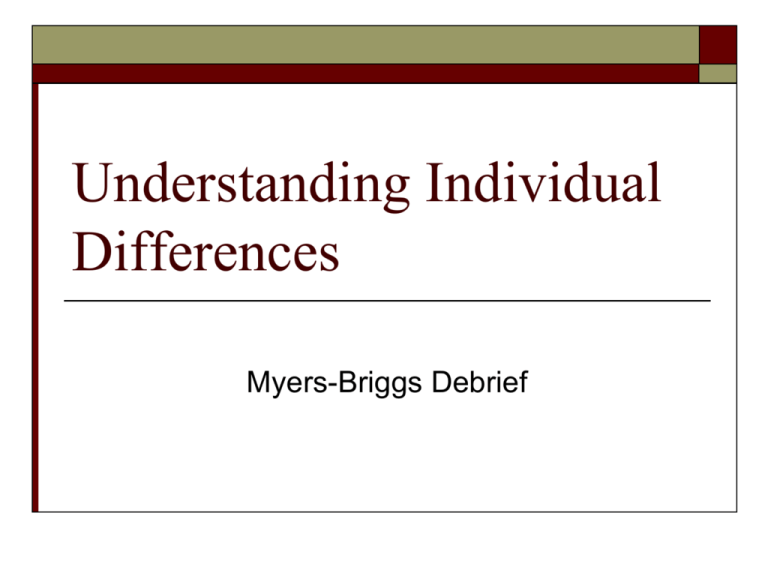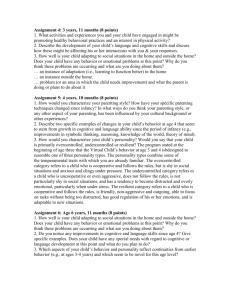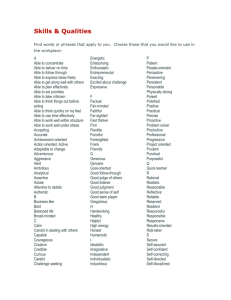Understanding Individual Differences
advertisement

Understanding Individual Differences Myers-Briggs Debrief Understanding Individual Differences Exercise Summary 1. How groups were formed for this exercise Using 2 dimensions of cognitive style Surveys you took were mini-version of real test Groups were not really cognitively homogenous 2. Questions: How did it feel to be part of a homogenous group? Could you sense that there was cognitive similarity? Understanding Individual Differences Exercise Summary 3. Outcomes: Cognitive diversity can lead to process loss and inefficiency or can lead to efficiency and teamwork. 4. Goal of this exercise: To minimize process loss by grouping people with common personality types. Understanding Individual Differences Exercise Summary 5. How to use this at work: If two dimensions have predictive value, we can make predictions about how others will behave. If we understand where individuals fit on these two dimensions, it may lead to clearer communications and better outcomes. We can create norms of interaction that respect differences Understanding Individual Differences The Two Dimensions Used in the Exercise ST: Problem focus: set up leadership and formal structure; work fast; define solutions not processes; concentrate on routines and procedures; Task oriented, look for cost/benefit. SF: People focus, hierarchical but open to unstructured situations, concerned about human qualities of people doing work as individuals, interest in maintaining good interpersonal and social relations a primary focus, focus on facts; how to handle problems with empathy. Understanding Individual Differences The Two Dimensions Used in the Exercise NT: Theoretical orientation, comfortable with complex situations, concentrate of defining problems, goals, analytical in the abstract; often create complicated procedures, using a messy process with little consensus. NF: Creative process, guided by insights and imagination emphasizing decentralized, humanistic organizations; Moral concerns with a “people orientation”, less concerned with structure. Comfortable with ambiguity. Understanding Individual Differences How we gather information: Sensing (S) – getting the facts, good at details, comfortable with standard solutions to problem solving, working with tested ideas Intuition (N) – developing data through insight and imagination, get bored with routine, see the possibilities, less concerned with facts, seek innovation, see the big picture Understanding Individual Differences How we make decisions: Thinking (T) – analytical, look for cost/benefit/ focus on analysis/prefer clarity, task oriented Feeling (F) – personal convictions or beliefs, can become committed to personal views, nostalgic, traditional, principles oriented Understanding Individual Differences How we choose priorities: Perceiving (P) – oriented towards generating data, can procrastinate, open minded and curious, comfortable with ambiguity Judging (J) – oriented towards decision making, clarity, order, dislike ambiguity, decisions are important not information gathering Understanding Individual Differences How we establish relationships: Extravert (E) – requires variety and stimulation, become bored easily, sociable, look for new situations, often viewed as influential, not easily organized, like meetings Introvert (I) – Think things through before communicating, harder to get to know, communication is more of a strain, few tasks at one time, few interruptions, others around the introvert often feel left in the dark Understanding Individual Differences Interpretation of Individual Scores Consider how cognitive differences affect organizational situations Four or more points viewed as a significant preference, less than four points means no clear preference on that dimension Does your score feel right? You can probably think of a situation where your behavior was inconsistent with your Myers-Briggs score No right or wrong answers, your results represent a lifetime of experience According to the theory, we all have the ability and potential to develop both sides the personality dimension Understanding Individual Differences Closing Thoughts There are differences based on country, culture, and experience Age and education influence personality Risk of organizational homogeneity Seek balance in your own personality, balance is the key to effectiveness and this ability resides within all of us To derive the best solution seek cognitive diversity, groups grasped only a part of the problem, best solution was a combination of ideas Psychological testing can deepen self-knowledge, and improve teamwork but can be misused in promotion and hiring decisions




